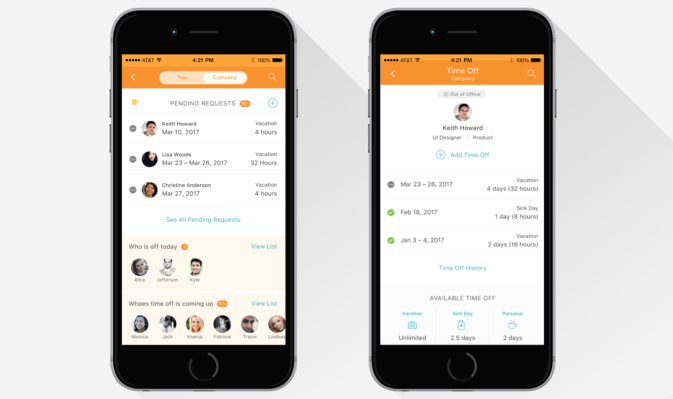Zenefits, in a further attempt to continue to find its way into small businesses as a human resources management service that can outmaneuver larger and more complex platforms, is releasing a suite of new updates today.
Much of these updates revolve around trying to simplify the process of managing an employee base, from benefits to payroll, to something as simple as a few taps on an app. Right now, they’ve worked on tools like time-off requests and clocking in and out, but it seems clear that as it tries to recoup the good will it lost amid a major compliance scandal that effectively halved its valuation Zenefits is trying to methodically make its way back into the small- to medium-sized business mindshare with a simpler product than a complex desktop-based dashboard.
Zenefits said around 30% of its daily users are now using the app on their mobile device, which contains a suite of employee functions like requesting time off and other things. Zenefits is trying to recreate the experience of being an employee and an HR administrator — not all that unlike the efforts of Square to re-imagine the experience of working every day and running a business — in a more seamless mobile fashion.
The efforts have gone so far as to try to bleed into the minor details of an employee’s life, such as their interactions within Slack. Employees, for example, can request time off via a Slack bot. The company now integrates with Microsoft Teams and will be a launch partner for Google Hangouts Chat, Zenefits senior director of product management Itai Turbahn said.
Zenefits, which to the casual observer seemingly be spending an alarming amount of time developing a way to request and monitor time-off requests from a phone, actually sees that as a critical part of their business. But that’s because it’s a web of regulatory issues, Zenefits product manager Caspar Yen said, and the company is trying to simplify that down into a mobile app where employees can request time off and managers can easily approve it. It’s a feature that may seem nominally complicated in Silicon Valley, but is something that’s table stakes when working with businesses that it’s trying to pitch its mobile experience.
“As soon as you go outside the valley, PTO becomes one of the top priorities for a company,” Yen said.”If you rewind 5 years ago, if you choose a random place in the US, people hate requesting time off now. No one wakes up and says today’s gonna be an exciting day and I’m gonna request time off. We had to rethink how to make this extremely easy to use. That required some rethinking of the approach.”
Probably the most interesting part of the announcement is a partnership with Aetna on level-funded employee health insurance plans. These plans shift more of the risk onto companies, but for smaller businesses that may have a healthier employee base they may make more sense with more consistent payments and the opportunity for cost savings. Zenefits is hoping to offer a wider suite of insurance plans as it tries to woo businesses, and plans like these can also help incentivize employers to keep their employee base healthy.
Zenefits is also adding reporting and analytics for HR managers so they can construct reports on their businesses’ employee activity. One example use case of such a business intelligence function would be helping HR managers get better snapshots of data simply for presentations to their bosses. But having all this information laid out into something legible that can communicate a concept in a single slide is probably something these managers would find valuable.
“There are insights that are built into [HR functions] that are very relevant for business,” Turbahn said. “CEOs and HR managers have very specific questions. We try to let them have a very easy platform to answer those questions. We’re not limiting to just building this ourselves, but we are building capabilities that we heard very loudly from customers that they expect to be in the Zenefits system. We try to optimize the product to solve for very different from use cases that other systems provide. We didn’t look as much as how do we get to parity with X or Y, we looked at what are the key questions that we can help these folks answer.”
